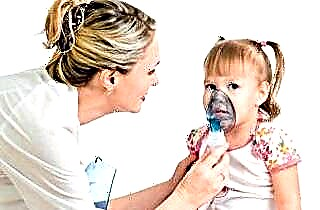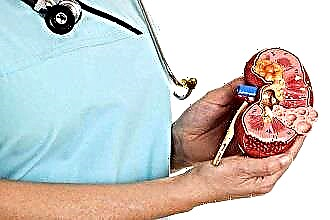As a response to general or local pathological processes in the body, the child often inflames the lymph node behind the ear, in the parotid region and on the neck. If an inflammatory reaction is confirmed, lymphadenitis is diagnosed, the treatment of which depends on the stage of the process, the type of primary disease, the degree of intoxication, etc. However, if the lymph nodes behind the ears of the child are enlarged due to lymphotropic viral infections, which include the herpes virus, infectious mononucleosis , adenovirus and cytomegalovirus, drug therapy is often unnecessary.
Causes of enlargement and inflammation of the lymph nodes behind the ear
 An increase in the bumps behind the ear most often becomes a manifestation of a reaction to the processes taking place in the nasopharynx and oral cavity. So, for example, if the general blood test showed no abnormalities, the child's condition is normal, the "lump" behind the ear does not hurt, and the remaining nodes of the lymphatic system are not enlarged, there is a high probability that teeth are being cut. In this case, no special treatment is required.
An increase in the bumps behind the ear most often becomes a manifestation of a reaction to the processes taking place in the nasopharynx and oral cavity. So, for example, if the general blood test showed no abnormalities, the child's condition is normal, the "lump" behind the ear does not hurt, and the remaining nodes of the lymphatic system are not enlarged, there is a high probability that teeth are being cut. In this case, no special treatment is required.
However, it is necessary to clearly distinguish between the concepts of "enlargement" and "inflammation" of the lymph node (lymph nodes) behind the child's ear.
In childhood, painless enlargement of "bumps" is detected regularly (sometimes several times a year) and often does not require an immediate medical response. After various viral diseases of the nasopharynx, the lymphatic system will necessarily respond by increasing the size of the nodules in closely spaced lymph groups (cervical, submandibular sometimes - parotid).
And although the increased size may persist for another month after the cure of the underlying disease, this in itself is not a sign of a dangerous inflammatory process.
If the child's lymph node is inflamed and sore behind the ear, an urgent need to consult a doctor who will both treat primary diseases and prevent the possible spread of the inflammatory process. Not every increase in the filtering node "station" leads to its inflammation. However, only a doctor can diagnose the condition of the peripheral lymphatic system based on a general blood test.
Inflammation differs from simple node enlargement:
- soreness (both constant and when touched),
- redness (blueing) of the skin over the "bump",
- an increase in temperature in the affected area,
 rapid swelling of the node during the day.
rapid swelling of the node during the day.
The change in the temperature of the skin over the "bump" changes with bacterial infections and, as a rule, does not change with viral ones.
Soreness behind the ear "bumps" may indicate a reaction to otitis media, sore throat, colds, flu, chronic tonsillitis, childhood infections (scarlet fever, diphtheria), skin diseases. At the same time, the very fact of a painful reaction of the lymphatic system is not enough for diagnosis. In order to accurately determine the causes of inflammation of the lymph nodes behind the ear (ears) in a child, the whole complex of symptoms is taken into account.
Adenovirus infection is manifested by nasal congestion, conjunctivitis, and sore throat. Rubella and measles are accompanied by a characteristic skin rash. With infectious mononucleosis, the spleen and liver enlarge, and all lymph groups swell. Inadvertent contact with pets (especially cats) can develop cat scratch disease, in which the group of lymph nodes serving the scratched area becomes inflamed due to infection with the bacterium. In this case, the sick take a course of antibiotics for 10-14 days. In viral diseases in the neck and head, there may be a multiple increase in small subcutaneous "buckshot" nodes.
Diseases related to potential causes of changes in the state of the lymph node can be conditionally divided into:
- immune (rheumatism, lupus erythematosus, etc.),
- infectious (for example, mononucleosis),
- tumor.
Specific lymphadenitis by the nature of the clinical picture are of the following types:
- Tuberculous. It is characterized by the involvement of several nodes on both sides, which are soldered into lumpy dense formations. The process may be accompanied by the release of pus or curdled mass in violation of the integrity of the capsule.
- Actinomycotic. It is characterized by a sluggish inflammatory process, which passes from the nodules to the surrounding tissues. It is accompanied by thinning and discoloration of the skin over the "bumps". One of the likely signs is the formation of a fistula with an exit to the outside.
- Bubonic. It occurs with tularemia and is characterized by an increase in the size of the nodular formation up to 3-5 cm, soldering with the underlying tissues, suppuration of bubo and the formation of a fistula with purulent discharge.
Monitoring the state of the lymphatic system and treatment
The process of forming immunity in adults and children differs in the degree of activity, therefore, the reaction the children's lymphatic system on the infectious process is a common and expected phenomenon that most often does not require a separate therapeutic intervention.
the children's lymphatic system on the infectious process is a common and expected phenomenon that most often does not require a separate therapeutic intervention.
However, in case of inflammation of the lymph node behind the ear, the child is prescribed treatment, while helping the doctor determine what to do if the lymph node is inflamed, a general blood test can be performed immediately before taking it. In the absence of pathology, to monitor the state of the lymphatic system, such a blood test (with the leukocyte formula present in it) is sufficient to be performed twice a year.
In general, the treatment of all secondary lymphadenitis is associated with the relief of infectious and inflammatory processes and with getting rid of the disease that led to the spread of viral, bacterial, fungal or tumor pathology.
With a successful cure of a viral disease, even with the preservation of an increased size of a painless node (and in the absence of other signs of suppuration), treatment of lymph formation is most often not prescribed. Within two weeks to a month, the behind-the-ear node usually returns to normal by itself. In this case, the behind-the-ear "bump" may not have time to completely disappear when the underlying viral disease recurs or when a new one appears in the service area of this lymphogroup. A situation is possible when the enlargement of the node first becomes a consequence of a viral infection, and after it - a reaction to an erupting tooth. That is, two different reasons alternately lead to the same effect, however, in both of these cases, the treatment of the lymphatic "lump" directly (for example, by applying an ointment) is not carried out.
In chronic and acute serous nonspecific lymphadenitis, conservative therapy is used:
- antibiotics (semi-synthetic penicillins, cephalosporins, macrolides),
- desensitizing agents,
- dry heat,
- compresses with Vishnevsky ointment,
- UHF,
- immunostimulants and vitamins.
In the absence of a therapeutic effect with conservative treatment or when lymphadenitis develops into a purulent phase, the child is hospitalized for an emergency opening of suppuration, drainage and sanitation of the focus.
With necrotizing lymphadenitis, various methods of removing foci of inflammation are used. In the postoperative period, a complex detoxification and anti-inflammatory treatment is performed.

 rapid swelling of the node during the day.
rapid swelling of the node during the day.

